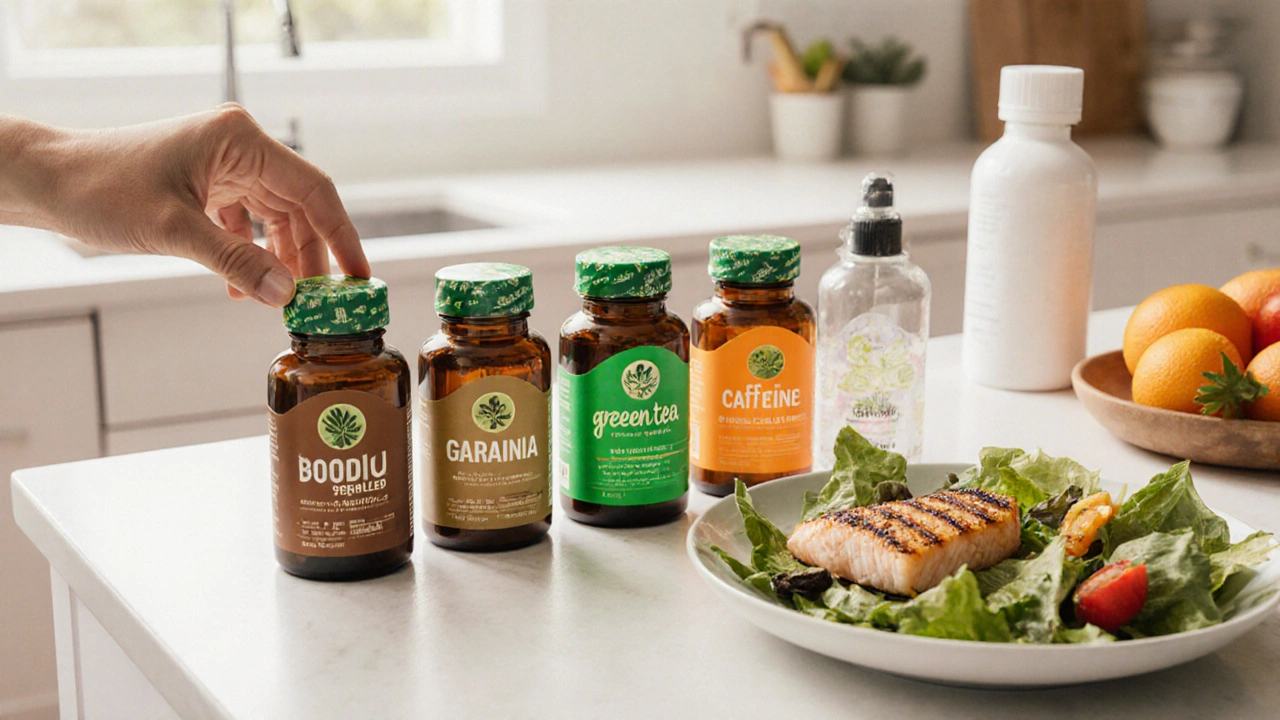
Hoodia vs Alternatives: Appetite Suppressor Comparison Tool
Use this tool to compare key characteristics of Hoodia and five popular natural appetite suppressants:
- Active Compound: The main ingredient responsible for the effect
- Primary Mechanism: How the supplement affects appetite or metabolism
- Typical Daily Dose: Recommended dosage ranges
- Evidence Rating: Based on clinical research quality and quantity
- Common Side Effects: Typical adverse reactions reported
- FDA Status: Regulatory classification of the supplement
| Supplement | Active Compound | Primary Mechanism | Daily Dose | Evidence Rating | Side Effects | FDA Status |
|---|---|---|---|---|---|---|
| Hoodia | Oxypregnane steroidal glycoside (P57) | Hypothalamic satiety signaling | 200–400 mg standardized extract | Low-Moderate | Dry mouth, nausea, stomach cramps | Not approved; dietary supplement |
| Garcinia cambogia | Hydroxy-citric acid (HCA) | Inhibits ATP-citrate lyase (fat synthesis) | 500–1500 mg with 50% HCA | Moderate | Headache, digestive upset | Not approved; OTC supplement |
| Green tea extract | Epigallocatechin gallate (EGCG) | Thermogenesis & fat oxidation | 300–500 mg EGCG | High | Rare liver enzyme elevation at high doses | Generally recognized as safe (GRAS) |
| Bitter orange | Synephrine | Beta-3 adrenergic activation | 10–20 mg | Low-Moderate | Increased heart rate, blood pressure spikes | Not FDA-approved for weight loss |
| Apple cider vinegar | Acetic acid | Delays gastric emptying, improves insulin sensitivity | 1–2 tbsp diluted in water | Low | Tooth enamel erosion, throat irritation | GRAS, no specific weight-loss claim |
| Caffeine | Caffeine | Central nervous system stimulant | 100–200 mg (≈1 cup coffee) | High | Jitters, insomnia, increased heart rate | GRAS, widely used in foods and drinks |
How to Interpret Evidence Ratings
Recommendations Based on Your Needs
When you hear about a supplement that claims to curb hunger, Hoodia often tops the list. But is it really the best choice, or are there other natural options that deliver similar or better results? This guide breaks down Hoodia’s chemistry, real‑world effectiveness, and safety profile, then pits it against the most popular alternatives so you can decide what fits your weight‑loss plan.
Key Takeaways
- Hoodia’s active oxypregnane steroidal glycoside shows modest appetite‑suppressing effects in short‑term studies.
- Garcinia cambogia, green tea extract (EGCG), and bitter orange provide comparable or stronger metabolic benefits, often with more robust research.
- Safety varies: Hoodia may cause digestive upset, while caffeine‑based options risk jitteriness and heart‑rate spikes.
- Regulatory status matters-only a few alternatives have FDA‑clearance for specific uses.
- Choosing the right supplement depends on your tolerance, health conditions, and whether you prioritize natural‑extract purity or proven clinical data.
What Is Hoodia?
Hoodia gordonii is a succulent plant native to the Kalahari Desert, traditionally used by the San people to stave off hunger during long hunts. The plant contains a unique compound class called oxypregnane steroidal glycosides, with P57 identified as the primary appetite‑suppressing molecule. Modern extracts aim to isolate this molecule while removing bitter tannins that cause unpleasant taste.
How Hoodia Suppresses Appetite
The oxypregnane steroidal glycoside binds to hypothalamic receptors that signal satiety, essentially telling the brain you’ve eaten enough. In lab animals, this pathway reduces food intake by 10‑15% over a 24‑hour period. Human trials are smaller: a 2019 crossover study with 24 overweight participants recorded a 7% reduction in daily calorie consumption during a 12‑week Hoodia regimen, but results were not statistically significant once placebo effects were accounted for.

Safety and Side‑Effect Profile
Most reported side effects are gastrointestinal-dry mouth, nausea, and occasional abdominal cramps. Because the extract is often combined with excipients like maltodextrin, allergy‑prone users should check labels carefully. Long‑term safety data are lacking; the FDA has not approved Hoodia as a drug, and it classifies the supplement under "dietary supplement" with a warning that manufacturers cannot claim weight‑loss benefits without rigorous studies.
Popular Natural Alternatives
Below are the top five alternatives that consumers frequently compare with Hoodia:
- Garcinia cambogia - a tropical fruit rind rich in hydroxy‑citric acid (HCA), which may block fat‑making enzymes.
- Green tea extract (EGCG) - high in epigallocatechin gallate, a catechin that boosts thermogenesis.
- Bitter orange (Synephrine) - a citrus alkaloid that stimulates beta‑3 receptors, increasing calorie burn.
- Apple cider vinegar - acetic acid promotes satiety and improves insulin sensitivity.
- Caffeine - a well‑studied stimulant that reduces perceived effort during exercise and suppresses appetite.
Side‑By‑Side Comparison
| Supplement | Active Compound | Primary Mechanism | Typical Daily Dose | Evidence Rating* | Common Side Effects | FDA Status |
|---|---|---|---|---|---|---|
| Hoodia | Oxypregnane steroidal glycoside (P57) | Hypothalamic satiety signaling | 200-400mg standardized extract | Low‑moderate (small human trials) | Dry mouth, nausea, stomach cramps | Not approved; sold as dietary supplement |
| Garcinia cambogia | Hydroxy‑citric acid (HCA) | Inhibits ATP‑citrate lyase (fat synthesis) | 500-1500mg with 50% HCA | Moderate (meta‑analysis shows ~1% weight loss) | Headache, digestive upset | Not approved; OTC supplement |
| Green tea extract | Epigallocatechin gallate (EGCG) | Thermogenesis & fat oxidation | 300-500mg EGCG | High (numerous RCTs support modest fat loss) | Rare liver‑enzyme elevation at high doses | Generally recognized as safe (GRAS) |
| Bitter orange | Synephrine | Beta‑3 adrenergic activation | 10-20mg | Low‑moderate (mixed results, some cardiovascular concerns) | Increased heart rate, blood pressure spikes | Not FDA‑approved for weight loss |
| Apple cider vinegar | Acetic acid | Delays gastric emptying, improves insulin sensitivity | 1-2 tbsp diluted in water | Low (small studies show modest satiety boost) | Tooth enamel erosion, throat irritation | GRAS, no specific weight‑loss claim |
| Caffeine | Caffeine | Central nervous system stimulant | 100-200mg (≈1 cup coffee) | High (extensive RCTs show appetite reduction & increased energy expenditure) | Jitters, insomnia, increased heart rate | GRAS, widely used in foods and drinks |
*Evidence rating reflects the breadth and quality of peer‑reviewed research up to October2025.

How to Choose the Right Appetite Suppressant
Consider these three factors before picking a supplement:
- Health conditions. If you have hypertension, stay clear of bitter orange and high‑dose caffeine. Diabetes patients may benefit from apple cider vinegar’s insulin‑modulating effect.
- Tolerance to stimulants. Hoodia and green tea extract are relatively mild, while caffeine can cause jitteriness even at moderate amounts.
- Evidence vs. tradition. If you need the strongest scientific backing, green tea extract or caffeine are leaders. If you prefer a traditional, plant‑based approach with fewer studies, Hoodia or Garcinia might appeal.
Practical Tips for Safe Use
- Buy from manufacturers that provide a third‑party certificate of analysis (COA) confirming the exact amount of the active compound.
- Start with the lowest recommended dose and monitor how your body reacts for one week before increasing.
- Pair any appetite suppressant with a balanced diet rich in protein and fiber; the supplement only aids, it doesn’t replace good nutrition.
- Consult a healthcare professional if you’re pregnant, nursing, taking prescription medication, or have chronic illnesses.
Frequently Asked Questions
Does Hoodia actually work for weight loss?
Short‑term studies suggest a modest reduction in calorie intake, but the effect is smaller than many users expect. Long‑term weight loss data are scarce, so Hoodia is best seen as a mild appetite cue rather than a magic bullet.
Can I stack Hoodia with other supplements?
Stacking is common, but it raises safety concerns. Combining Hoodia with caffeine or bitter orange can amplify cardiovascular stress. If you choose a stack, keep total stimulant load below 200mg of caffeine‑equivalent per day and watch for any adverse symptoms.
Is there a risk of addiction?
No strong evidence links Hoodia or most natural appetite suppressors to chemical dependence. However, psychological reliance on any supplement for weight control can develop, so use them as short‑term tools, not lifelong crutches.
How do I verify product purity?
Look for a COA that lists the percentage of the active molecule (e.g., P57 ≥10%). Reputable brands also display batch numbers and third‑party lab logos like NSF or USP.
What should I do if I experience side effects?
Stop the supplement immediately and hydrate. If symptoms persist beyond 24hours, seek medical advice. For mild stomach upset, taking the capsule with food often helps.
Bottom Line
While Hoodia vs alternatives is a hot topic, the data show Hoodia delivers only a gentle appetite cue, making it a decent option for those who prefer a low‑stimulant, plant‑based product. However, if you want stronger, research‑backed results, green tea extract or caffeine outperform Hoodia on both fat loss and metabolic rate, provided you can tolerate the mild side effects. Always prioritize quality testing and consult a health professional before committing to any supplement regimen.
11 Comments
Write a comment
More Articles

8 Aducanumab Alternatives: What Else is Out There for Alzheimer's?
Confused by the options beyond Aducanumab for Alzheimer's? This article breaks down eight alternatives, from experimental drugs to currently available treatments. Each option gets compared side by side for how well it works, how it's taken, and what people have actually experienced. You'll find helpful details and clear pros and cons for each, including why some promising ideas just didn’t pan out. It's practical, candid, and tailored for anyone wondering what’s really out there besides Aducanumab.



William Goodwin
October 6, 2025 AT 16:43Whoa, diving into the world of appetite suppressants feels like stepping into a sci‑fi novel where every capsule claims to be a miracle 🌟. Hoodie's desert heritage is fascinating, but the science kinda whispers that the effect is modest at best. On the other hand, green tea and caffeine are backed by solid RCTs, making them the real MVPs for most folks. If you’re chasing a mild, plant‑based vibe, Hoodia could fit, yet you might still be better off with a cup of tea. Bottom line: match the supplement to your tolerance, not the hype 🚀.